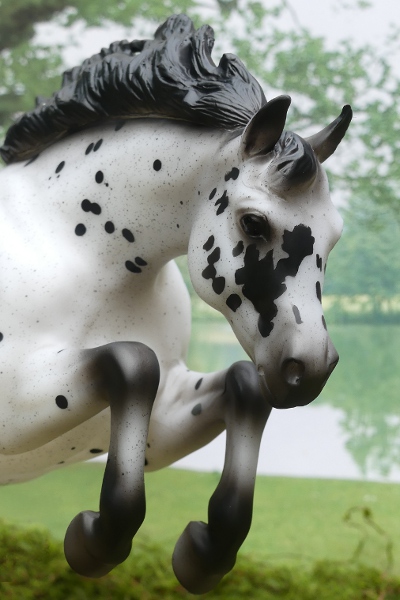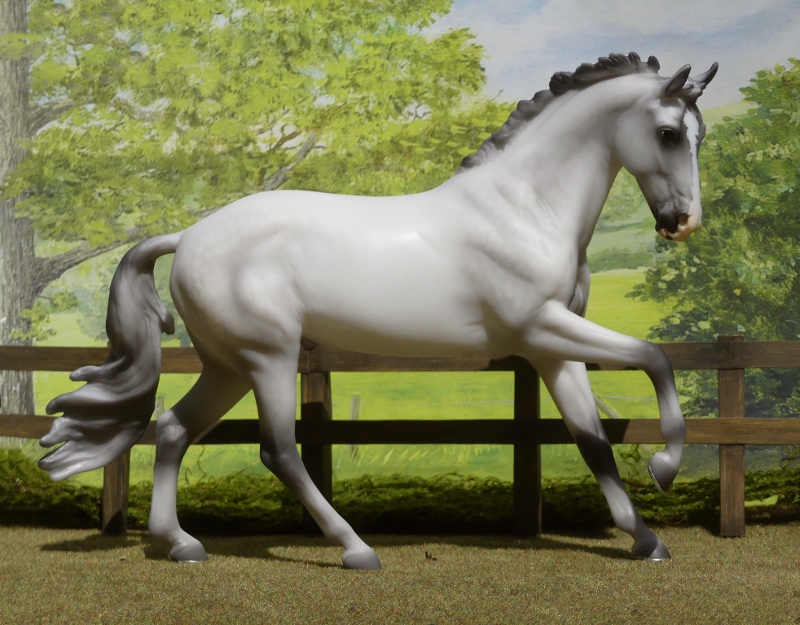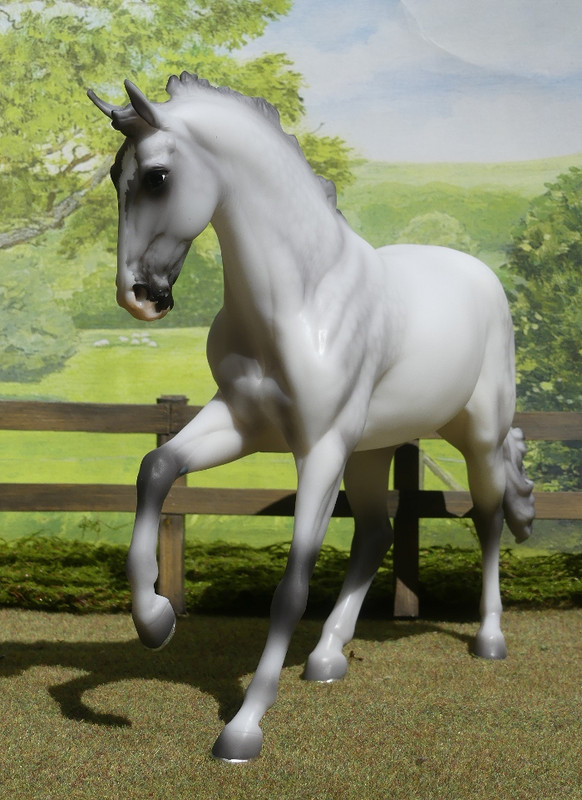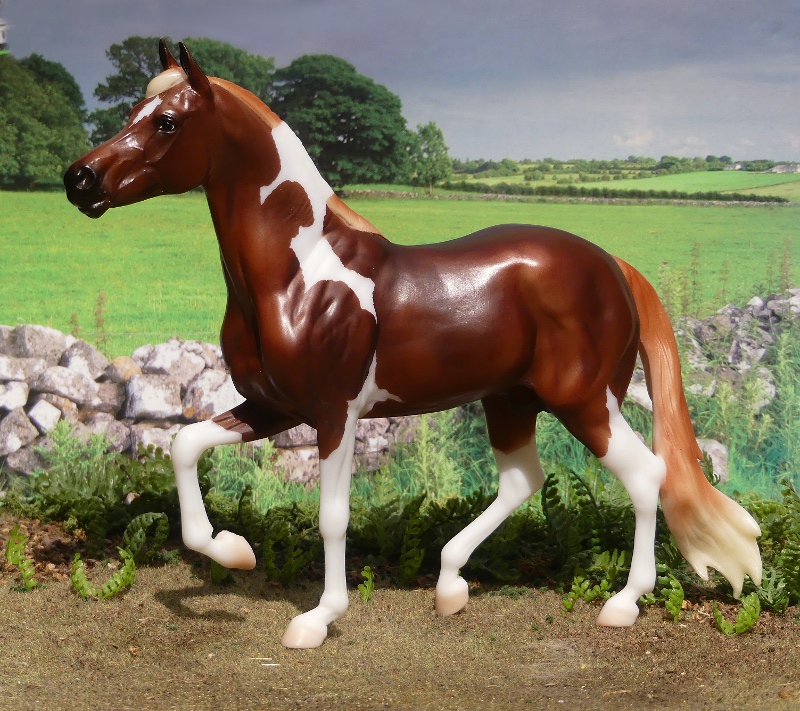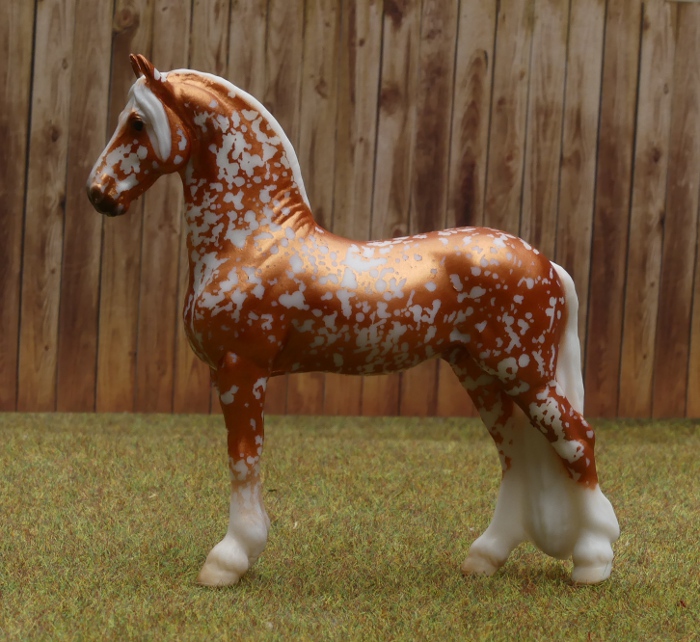Last time, I wrote about the small unintended variations in OF models, how one painter might handle the airbrush just a little differently than another, leaving us with models more shaded, more speckled, more dappled, and so on. This time, I've bought a model who was specifically designed to vary from horse to horse : 2018 regular run EZ To Spot.
Introducing EZ To Spot (let's just shorten that to 'Spot' from now on, as 'EZ' just doesn't work to my British-English-speaking mind : that spells out Eezedd or possibly a shouted Ezz!, but never Easy!), a sort of hybrid mix between two of Breyer's ways to paint appaloosas.
Sometimes they design a masking pattern to outline all the spots more or less exactly in the shapes and places they want them, and sometimes they use a rather more haphazard paint-spatter technique which gives random spotting spread anyhow across the body.
Trads mostly get the masking method, Stablemates tend toward the spattering because it's easier and cheaper for something so small and low-cost; you really only see SM scale masked appy patterns on the more expensive and exclusive special runs.
Spot is curious because he's got masked spots on his head and hindquarters, the rest of him is done with paint spatter. He's a portrait of a real pony, so they could have gone for the usual fully masked spotting to make him as true to life as possible (Lil Ricky Rocker proves that even the all-over spotting of a leopard appy pattern isn't considered too much effort for a regular run), but instead they chose to leave that whole middle section of him to chance, and let each pony vary.
I've no idea what reason could've been behind this decision, but it does at least mean that collectors can tell their Spot from any Spots their friends own, or any that might come nose to nose on a live show table!
The other side, I'm not sure which side I like best to choose his website/showing photo, maybe this one as I knelt a little lower so the angle's slightly more realistic.
The fact the spots vary from model to model means it's a bit pot-luck whether you get a 'good' one or a 'bad' one - although it's a matter of personal taste : one buyer might think a lot of spots makes a good one, while another would be choosing based on the placement of the spots and not mind that there's very few of them.
I've spent some time looking at real people's photos of Spot, both collectors' out-of-box models, and Ebay listings where the seller's taken their own photo rather than relying on the Breyer stock image alone. And there really is a huge variation in the spotting, both in the number of dots and how they're spread out - mine seems about middle of the range in the amount of spots which hit home when the paint started to fly (just imagine how messy the factory floor would've been after a batch of these went through it!)
I almost didn't end up with a Spot of my own, last year I liked him from the promo photo but never got round to ordering him, and eventually saw one in person on a trade stand at Burghley - I dithered but ended up leaving him behind...and regretted it almost immediately! I almost went back at the end of the afternoon, hoping he hadn't sold, but after a long baking-hot day round the hilly cross country course in a packed crowd, I just couldn't face the walk all the way back in from the car park. Later, I had a look for him online, and everywhere had sold out, so I just kind of left him lingering on my mental wishlist, incase I ever saw a second hand one in need of a home.
So when the very same trade stand still had Spot in stock at a different horse trials this summer, I picked him up and didn't let go :D
I do really like this little jumping pony mould, I've ended up with every regular run except the very first release (I have a deep aversion to pearly paint!)
Yet to settle for sure on a name, though I've got a couple of ideas, I'm also undecided whether to show him as a British Spotted Pony, or the Pony of the Americas Breyer sell him as - I have a feeling the POA breed is a bit more stock-horse typey, and the mould was sculpted as a British native pony breed, so mine may change nationality!
Yet to settle for sure on a name, though I've got a couple of ideas, I'm also undecided whether to show him as a British Spotted Pony, or the Pony of the Americas Breyer sell him as - I have a feeling the POA breed is a bit more stock-horse typey, and the mould was sculpted as a British native pony breed, so mine may change nationality!
Each side of his face, showing off that big blob of spots all merged together!
All in all, a decent paintjob on a mould I like a lot, and the paint technique amuses rather than disappoints me - I doubt I'd have bought him if he'd been spatter-spotted all over, but the fact it's combined with realistic masked spotting too makes the general look of him so much better.
The only thing I'd say seems lacking is the pink speckling of the muzzle so characteristic of appaloosa patterns, the real pony has it so it's a shame that detail never made it to the model version.





